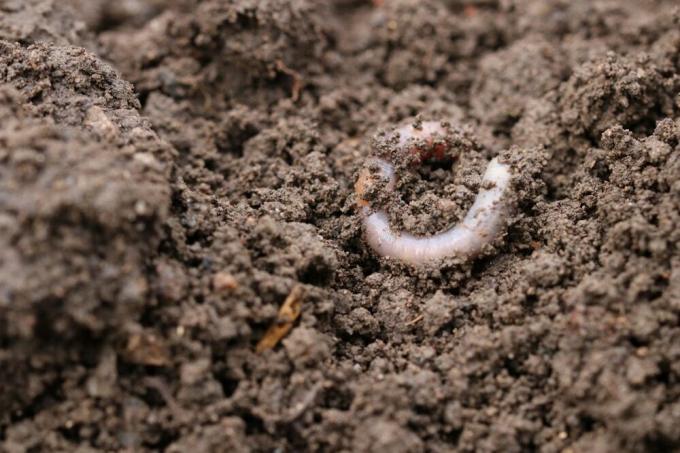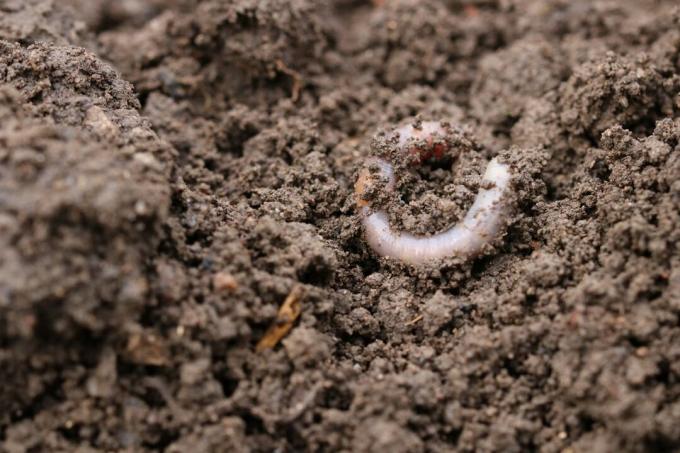

Table of contents
- Reasons for soil loosening
- Manual soil loosening devices
- digging fork
- rake
- spade
- sow tooth
- cultivator
- Electric soil loosening
- electric hoe
- motor plow
- Electric tiller
Regular loosening of the soil is just as necessary in the home garden as it is in agriculture. Many hobby gardeners prefer the manual device for loosening the soil, others find it faster and easier with machines. But what kind of devices and machines are actually suitable for loosening soil can be read in the following.
Reasons for soil loosening
humidity
All soil compacts over time. Soil compaction causes the soil to become less permeable to water, making it harder for water to penetrate and drain away. The result is a lack of moisture or the formation of waterlogging. In both cases, plants and seeds are damaged and may die.
Air
The roots of all plants need air in order to establish themselves ideally or to penetrate the soil. If this is too tight/firm, this is impossible. Plants cannot gain a foothold and root growth is disrupted because there is not enough space to spread. This leads to general growth disorders and possibly to the death of affected plants.
nutrient
With solid soil, the nutrients encapsulate themselves so that they cannot be absorbed by the roots. Deficiency symptoms follow due to an undersupply of nutrients and without loosening the soil, the plants will die. By loosening the soil consistency decomposes and nutrients are again freely accessible for the plant roots.
soil preparation
In many cases, before sowing or planting, the soil is prepared in the form of loosening of the earth required to create ideal conditions to "tackle", for reasons already described became. But also for a follow-up treatment, such as levelling, it may be necessary to loosen the soil beforehand in order to create an ideal soil condition overall. For example, without loosening the soil beforehand, leveling would entail too high a risk of compaction.
weed
Weeds are usually an unwelcome guest, especially in vegetable beds. By loosening the soil, most weeds lose ideal conditions and die or don't settle at all. The firmer and denser the soil, the more and faster weeds will grow.
Manual soil loosening devices
In principle, for every device that can be used manually, there is also a mechanical answer for the most diverse methods of tillage. While handheld devices often require strength and endurance and also take a lot of time, the same garden work is easier and much faster with electric machines Hand. However, with manual devices it is easier to react to irregularities and, if necessary, to work more precisely than with mechanical devices. In addition, manual devices are usually much cheaper to buy than garden machines. However, these are worthwhile at the latest when it comes to larger areas that are to be loosened up.
digging fork

The digging fork is constructed similar to a classic pitchfork. It is an ideal alternative to the spade when the ground is extremely hard and it is difficult or impossible to get into it with a spade. A digging fork is more suitable for loamy and stony subsoil in particular. The fork-like arrangement of the tines makes it easy to guide them past stones and the like, while the pointed tines are easier to dig into heavily compacted soil. Digging forks with flat and wide sides are suitable. Wide specimens speed up the work. In addition to loosening the soil, the digging fork is also an advantage for other garden work:
- digging up
- implementation of compost
- floor ventilation
A NOTICE:
The digging fork or digging fork are often also referred to as spade forks, garden forks or wide rakes and are offered in stores with these names.
rake
The most classic of all garden tools is the simple rake. It is available in different versions. But they all have one thing in common: tines that are attached like a comb, which are usually only used to loosen the surface of the soil.
hand rake
A hand rake does not have a long handle, so it lies directly in the hand. It has a maximum of five tines, is therefore narrow and is therefore less suitable for larger areas. Small beds and, above all, narrow areas of soil can be ideally loosened up with it. With pressure, the tines can also penetrate deeper into the soil and loosen the soil correspondingly deeper.
stick rake
With a handle rake, a rake attachment and a handle are usually sold separately. The rake attachment is attached to it in order to be able to loosen the soil while standing thanks to a handle length of up to 1.60 meters. Here, too, the loosening of the soil is mainly superficial and for a deeper earthwork, significant pressure must be exerted with the manual rake. The rake width is selectable between 30 and 40 centimeters. This means that larger areas of earth can be worked on.
spade
The spade consists of a relatively flat metal plate which has a sharp outer edge. The spade is used to dig into the ground and can loosen the soil by digging. The depth reaches about 30 centimeters. Too much should not be dug up in one area, as this can have a negative effect on the microorganisms and consequently also negatively affect the nutrient accumulation.
Other areas of application are:
- root divisions
- Cutting off lawn and bed edges
- digging roots
- digging planting holes
sow tooth
A sow tooth is a typical soil loosening device. It consists of a handle with a sickle-shaped metal blade attached to the end. The sow tooth acts as a plow, digging through dense soil without turning it over. This has a positive effect on the microorganisms, which remain in the soil as a result. The operation requires a certain physical effort, because in order to get into the ground ideally, the device has to be moved vigorously. The advantage is that no bending is required and back-friendly work is possible.
Tip:
Copper alloy blades are said to improve soil fertility and keep it healthier.
cultivator

A cultivator is a gardening tool that loosens and crumbles the soil without turning the soil like a spade does. A cultivator usually comes with knife-like wheels that have sharp tines on them. The manual version is pushed by hand. There are also versions with a handle and three tines. The cultivator is often used to scarify lawns. It ensures better ventilation and water permeability on the earth's surface. It is also used to prepare the soil for fertilizing.
Electric soil loosening
In addition to individual machines that serve a purpose, multi-purpose machines can also be purchased. Mobile single-axle machines, known as lawn mowers, are also available for use in soil loosening. It depends on what work needs to be done. The range offers a large selection of device accessories for a wide variety of uses, such as for
- scarify
- tillers
- rake
- Plow
- leaf vacuuming
- Push snow
- Harrow
- Cut the grass
If you only need a specific device, you can get away financially with a simple device, but at the same time you do without flexibility for gardening. Basically, the following electrical machines or electrical devices are used to loosen the soil:
electric hoe
Electric hoes have only been commercially available for some time. They have the same properties as a conventional rake and can also loosen up the surface of the soil. However, they can be bought in larger widths of up to 55 centimetres, so that larger areas of earth can be worked even faster. Like a lawn mower, the electric hoe is pushed in front of you. It often stalls on very uneven floors, which is due to the mostly limited performance. It is offered with a power cable connection and with battery operation. The former has the disadvantage that a socket has to be nearby and the cable can get in the way when working on the ground. Depending on the battery performance, cordless tillers can severely disrupt working hours if the battery is empty but the work has not yet been completed.
motor plow
Motor plows are usually equipped with so-called hoe stars, which turn roughly and much deeper into the ground than electric hoes. They churn up the earth and provide "air channels". Motor hoes are often offered whose attachment can be changed and equipped with other useful garden attachments. In this way, one device can easily be turned into an all-round machine for private use, which can also be used to push snow or scarify the lawn.
Electric tiller
An electric tiller, which is also sold under the name "garden tiller", is ideal for large areas of land. It gets quite deep into the ground and digs up the layers of earth. A tiller is particularly suitable for areas of land with heavy weed growth because it loosens even the deepest weed roots. It is available with an electric motor and power cable connection as well as with a petrol engine for more freedom of movement and flexibility with regard to the area of application.
 garden editorial
garden editorial I write about everything that interests me in my garden.
Learn more about floor care

Digging up the garden: 13 tips for lawns and beds
Whether it makes sense to dig up beds or lawns is discussed in different ways. Once you have decided on this measure, our tips will help you to organize work in the garden effectively.

Pine bark: suitable for which plants?
Pine bark is a type of mulch that is gaining popularity among many garden owners due to its color and properties. Before purchasing, the question often arises as to which plants the bark mulch is suitable for. This question is justified because of the origin of the pine.

Which soil to choose for elephant foot?
The right substrate is crucial for the elephant's foot and should therefore be chosen well. Read here which soil is best suited for the Beaucarnea recurvata!

Expanded clay as a water reservoir: The alternative to earth?
Expanded clay is known to many as a substrate for hydroponics or as drainage in pots. Due to its properties, the clay granulate is suitable as a substrate in many different areas and can replace soil. The granules have long been an indispensable basis for green roofs.

Potting soil: Mix the potting soil yourself
Potting soil has to meet special requirements. It can therefore often make sense to mix potting soil yourself. This comes with several advantages. But what do you have to pay attention to? The guide below shows how to do it.

pH value in the soil: 15 tips for measuring & regulating
If the pH of the garden/plant soil is suboptimal, this can lead to serious plant damage. We show what options there are for measuring and regulating.

